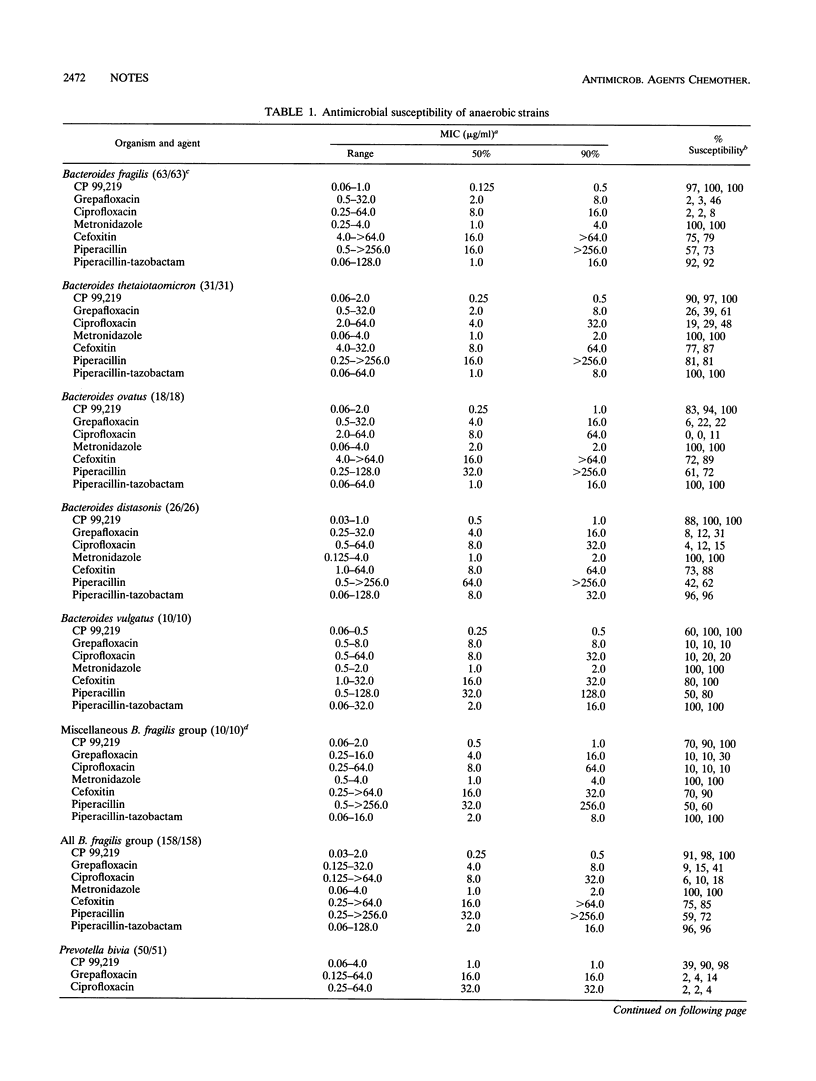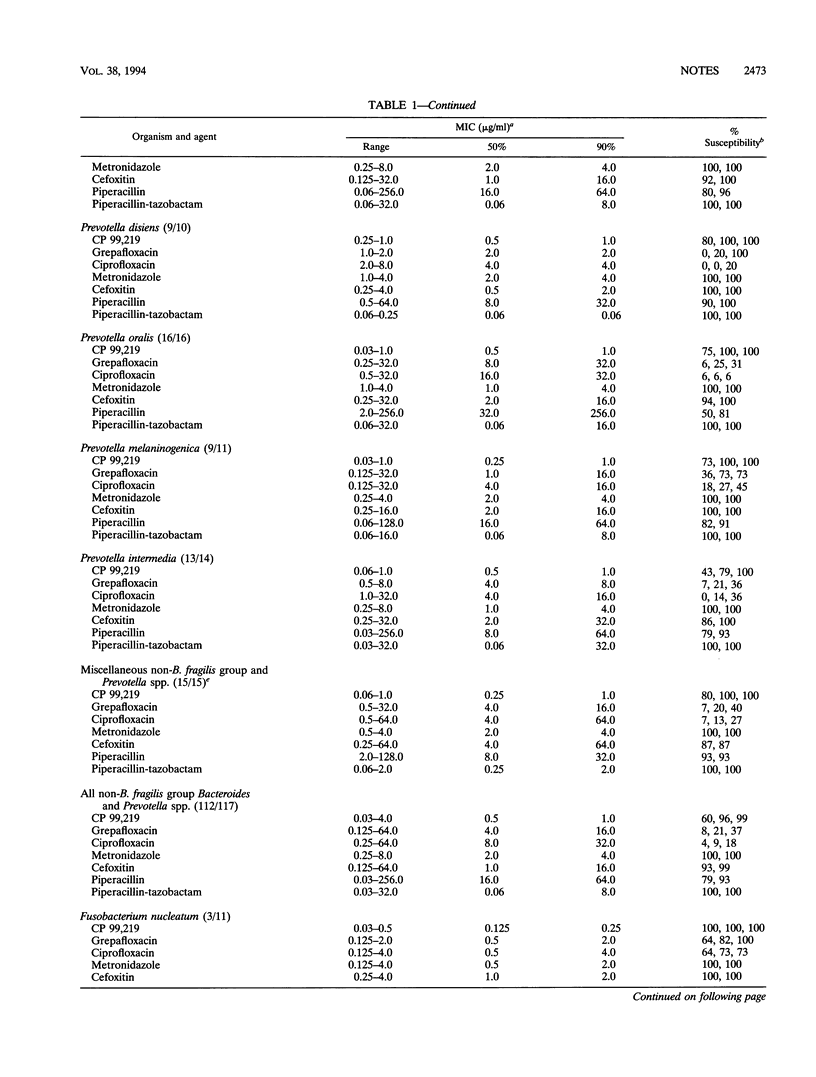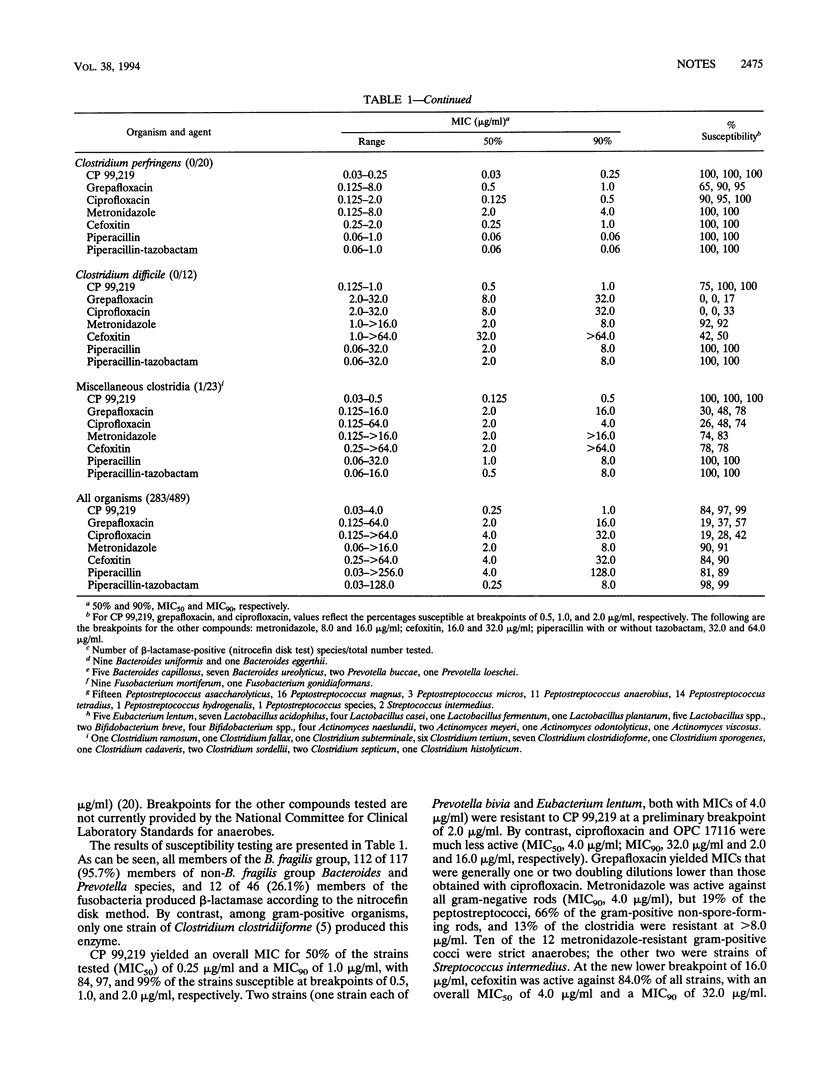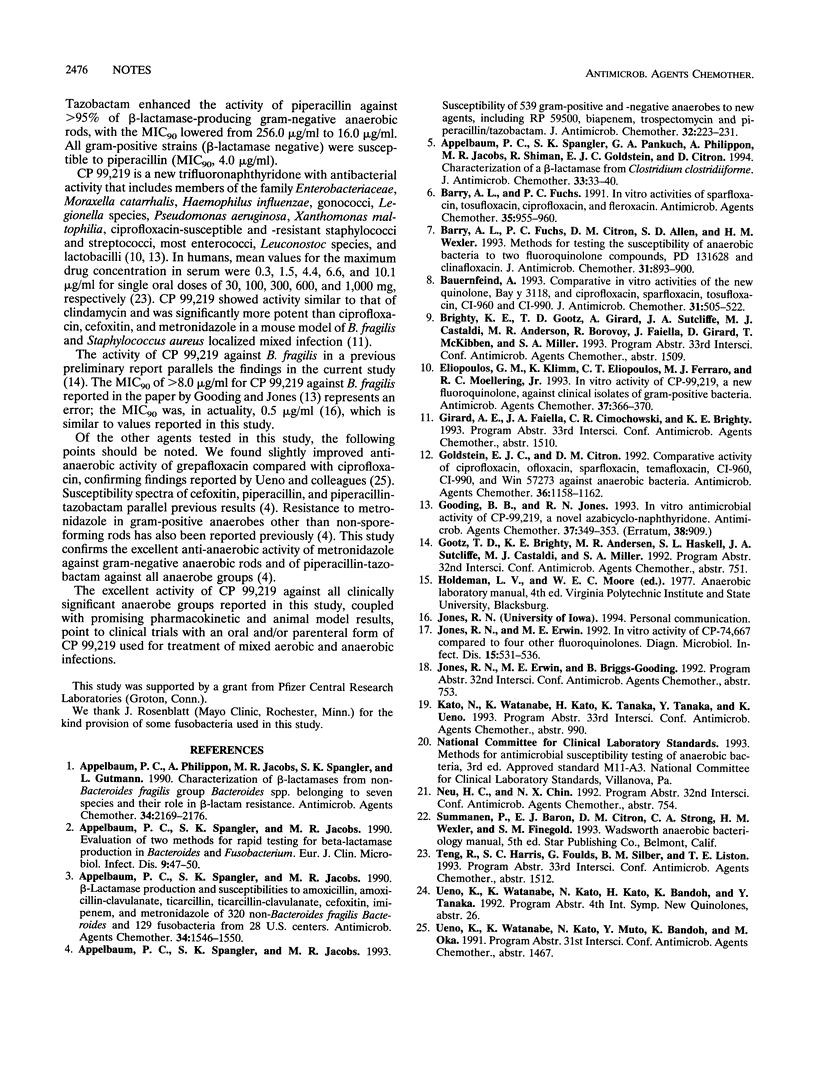Abstract
Agar dilution was used to compare the in vitro activity of CP 99,219 with those of ciprofloxacin, grepafloxacin, metronidazole, cefoxitin, piperacillin, and piperacillin-tazobactam against 489 anaerobes. CP 99,219 yielded a MIC for 50% of the strains tested (MIC50) of 0.25 micrograms/ml and a MIC90 of 1.0 microgram/ml, with 99.6% of the strains susceptible at a breakpoint of 2.0 micrograms/ml. Ciprofloxacin and grepafloxacin were less active (MIC50, 4.0 micrograms/ml; MIC90, 32.0 micrograms/ml and 2.0 and 16.0 micrograms/ml, respectively). Metronidazole was active against all gram-negative rods (MIC90, 4.0 micrograms/ml), but 31% of the gram-positive anaerobes were resistant at > 8.0 micrograms/ml. Cefoxitin was active against 84% of all strains at < or = 16.0 micrograms/ml, with a MIC50 of 4.0 micrograms/ml and a MIC90 of 32.0 micrograms/ml. Tazobactam enhanced the activity of piperacillin against > 95% of the beta-lactamase-producing gram-negative anaerobic rods (MIC90, 16.0 micrograms/ml).
Full text
PDF





Selected References
These references are in PubMed. This may not be the complete list of references from this article.
- Appelbaum P. C., Philippon A., Jacobs M. R., Spangler S. K., Gutmann L. Characterization of beta-lactamases from non-Bacteroides fragilis group Bacteroides spp. belonging to seven species and their role in beta-lactam resistance. Antimicrob Agents Chemother. 1990 Nov;34(11):2169–2176. doi: 10.1128/aac.34.11.2169. [DOI] [PMC free article] [PubMed] [Google Scholar]
- Appelbaum P. C., Spangler S. K., Jacobs M. R. Beta-lactamase production and susceptibilities to amoxicillin, amoxicillin-clavulanate, ticarcillin, ticarcillin-clavulanate, cefoxitin, imipenem, and metronidazole of 320 non-Bacteroides fragilis Bacteroides isolates and 129 fusobacteria from 28 U.S. centers. Antimicrob Agents Chemother. 1990 Aug;34(8):1546–1550. doi: 10.1128/aac.34.8.1546. [DOI] [PMC free article] [PubMed] [Google Scholar]
- Appelbaum P. C., Spangler S. K., Jacobs M. R. Evaluation of two methods for rapid testing for beta-lactamase production in Bacteroides and Fusobacterium. Eur J Clin Microbiol Infect Dis. 1990 Jan;9(1):47–50. doi: 10.1007/BF01969535. [DOI] [PubMed] [Google Scholar]
- Appelbaum P. C., Spangler S. K., Jacobs M. R. Susceptibility of 539 gram-positive and gram-negative anaerobes to new agents, including RP59500, biapenem, trospectomycin and piperacillin/tazobactam. J Antimicrob Chemother. 1993 Aug;32(2):223–231. doi: 10.1093/jac/32.2.223. [DOI] [PubMed] [Google Scholar]
- Appelbaum P. C., Spangler S. K., Pankuch G. A., Philippon A., Jacobs M. R., Shiman R., Goldstein E. J., Citron D. M. Characterization of a beta-lactamase from Clostridium clostridioforme. J Antimicrob Chemother. 1994 Jan;33(1):33–40. doi: 10.1093/jac/33.1.33. [DOI] [PubMed] [Google Scholar]
- Barry A. L., Fuchs P. C., Citron D. M., Allen S. D., Wexler H. M. Methods for testing the susceptibility of anaerobic bacteria to two fluoroquinolone compounds, PD 131628 and clinafloxacin. J Antimicrob Chemother. 1993 Jun;31(6):893–900. doi: 10.1093/jac/31.6.893. [DOI] [PubMed] [Google Scholar]
- Barry A. L., Fuchs P. C. In vitro activities of sparfloxacin, tosufloxacin, ciprofloxacin, and fleroxacin. Antimicrob Agents Chemother. 1991 May;35(5):955–960. doi: 10.1128/aac.35.5.955. [DOI] [PMC free article] [PubMed] [Google Scholar]
- Bauernfeind A. Comparative in-vitro activities of the new quinolone, Bay y 3118, and ciprofloxacin, sparfloxacin, tosufloxacin, CI-960 and CI-990. J Antimicrob Chemother. 1993 Apr;31(4):505–522. doi: 10.1093/jac/31.4.505. [DOI] [PubMed] [Google Scholar]
- Eliopoulos G. M., Klimm K., Eliopoulos C. T., Ferraro M. J., Moellering R. C., Jr In vitro activity of CP-99,219, a new fluoroquinolone, against clinical isolates of gram-positive bacteria. Antimicrob Agents Chemother. 1993 Feb;37(2):366–370. doi: 10.1128/aac.37.2.366. [DOI] [PMC free article] [PubMed] [Google Scholar]
- Goldstein E. J., Citron D. M. Comparative activity of ciprofloxacin, ofloxacin, sparfloxacin, temafloxacin, CI-960, CI-990, and WIN 57273 against anaerobic bacteria. Antimicrob Agents Chemother. 1992 May;36(5):1158–1162. doi: 10.1128/aac.36.5.1158. [DOI] [PMC free article] [PubMed] [Google Scholar]
- Gooding B. B., Jones R. N. In vitro antimicrobial activity of CP-99,219, a novel azabicyclo-naphthyridone. Antimicrob Agents Chemother. 1993 Feb;37(2):349–353. doi: 10.1128/aac.37.2.349. [DOI] [PMC free article] [PubMed] [Google Scholar]
- Jones R. N., Erwin M. E. In vitro activity of CP-74667 compared with four other fluoroquinolones. Diagn Microbiol Infect Dis. 1992 Aug;15(6):531–536. doi: 10.1016/0732-8893(92)90104-2. [DOI] [PubMed] [Google Scholar]


